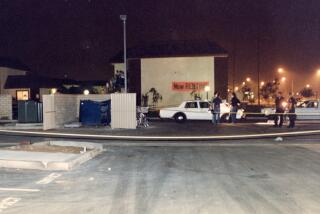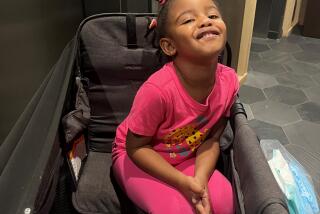A girl with two graves: The past haunts a city that evicted its dead

They found her buried under a garage earlier this year, her small body perfectly preserved in an airless, metal casket.
She wore a white christening dress with hand-stitched lace that would have dragged along the ground when she walked. Her blond hair had been laced with sprigs of lavender and a rosary of eucalyptus seeds lay on her chest.
She is believed to have died around 1870, when pinewood coffins sold for $2. Her elaborate glass and cast-iron vessel would have cost 10 times that much.
We need to know this little girl’s name. Someone needs to say this girl’s name again.
— Steven Sederwall, a retired LAPD detective
But neither the girl’s name nor details of her demise were anywhere to be found.
Her coffin was unearthed when construction workers broke through the concrete floor of a home under renovation in San Francisco’s Richmond district. The grim discovery this spring riveted the city, sparking an outpouring of posthumous grief and an intensive effort to identify her. How was it possible, people wondered, that a 3-year old who was so lovingly interred could be so thoroughly forgotten?
“We need to know this little girl’s name,” said Steven Sederwall, a retired Los Angeles police detective who is among those who have been moved by her sudden celebrity. “Someone needs to say this girl’s name again.”
Finding that out, however, has proved harder than anyone could imagine.
::
The clump of hair was plucked from the girl’s bangs carefully, but not professionally, and the follicles that Jelmer Eerkens hoped would be in abundance were scarce.
The follicle tissue can provide decent samples of nuclear DNA, which contains genetic information from both parents. To date, experts have only been able to sequence the girl’s mitochondrial DNA, which shows the genetic background of her mother.
But within those thin shafts of hair lies a trove of useful information, said Eerkens, an archeology professor at UC Davis.
“She has a pretty rare type of maternal ancestry,” he wrote in an email. “We don’t know a lot about it, but everyone living today, so far, who has this DNA signature is from the British Isles.”
The delicate locks also may provide clues as to how the mystery girl lived.
An analysis of carbon and nitrogen isotopes in her hair showed that in the last two or three months of life, the girl endured dramatic weight loss consistent “with some type of drawn-out disease,” as opposed to a sudden accident or fast-killing virus like smallpox or measles, he said.
Further tests could reveal the region she grew up in and traces of heavy metals could offer clues to what medicines doctors used to treat her.
“As an archaeologist, I’m interested in things we can learn from the past,” Eerkens said. “These lives we live … it’s important we record these things.”
::
According to historians, when San Francisco was in its infancy, residents and businesses coalesced around San Francisco Bay. The dead were buried in what is now the financial district.
But then came the Gold Rush of 1849, which flooded the city with new residents, new illnesses and death. Bodies in the financial district were exhumed and relocated west, closer to the ocean, to make way for the mass migration.
By the late 1880s, there were dozens of cemeteries in San Francisco, and most were full. Officials and developers deemed the burial grounds as more valuable to the living, and launched a decades-long campaign to evict the dead.
City crews and cemetery workers hauled hundreds of thousands of corpses south to what is now Colma. Today the city has about 1,500 living residents and more than 1.5 million bodies underground, including such historic figures as Wyatt Earp and William Randolph Hearst.
But Sederwall, a self-described cowboy from Texas who spends his post-law enforcement career solving centuries-old homicide cases, doubts all of the dead ever made it to Colma.
His research has found that workers simply dug straight trenches through the cemeteries and pulled out whatever bodies they hit along the way without minding maps or blueprints of the grounds to locate them all.
During a massive retrofitting project for San Francisco’s Legion of Honor fine arts museum in 1993, the remains of more than 700 people were unearthed.
“What that tells me is you’ve got a playground that’s probably got children under it. Houses with bodies,” Sederwall said.
He believes the mystery girl was one of those left behind.
Less than 100 yards from where the girl in the casket was found, a headstone for another man from roughly the same era was discovered, Sederwall said.
As he and his staff would come to learn, the area where the headstone and casket were found used to be part of the Odd Fellows Cemetery.
::
“We have thought that there was a presence in the house. It didn’t really have any explanation for thinking we heard little footsteps,” said Ericka Karner, who with her husband and two daughters lived in the home where the girl was found. “I don’t know. I wasn’t necessarily spooked.”
Karner’s family has owned the home on Rossi Avenue since 1976. Growing up, the morbid history of the area was common knowledge, as was the possibility of unseen neighbors just below their feet.
“I had heard that during renovations that this does happen on occasion. But it’s not something as a homeowner you’re prepared to deal with,” Karner said.
She and the family were vacationing in Idaho when workers tearing out the garage floor to build a new living room happened upon the casket.
They sent her photos and contacted the San Francisco medical examiner, who came, unsealed the casket, verified it was a real body, then left without taking on the case because officials decided it had been properly, legally interred 140 or so years ago.
The medical examiner’s office did not return repeated requests for comment on this story.
“From a common sense standpoint, the city was the one that relocated bodies. They missed some. To many it seems like the city would still be responsible,” Karner said.
Unsealed and exposed to the elements, the body began to rapidly decay.
Suddenly, time was of the essence.
“For me, it always goes back to being a parent and I can’t imagine losing a child … it’s no different today than it was in the 1880s,” Karner said. “What was important for me was making sure the next steps were respectful to this individual …. The way she was buried and preserved – it’s an indication she was well-loved and cherished.”
Karner spoke with the city administrator’s office, which said it couldn’t help, but pointed her to Elissa Davey. The founder of the Garden of Innocence, an organization that buries abandoned and unidentified children, was just as adamant that the girl receive a proper burial as Karner was.
::
Davey tapped her network of genealogists and grave hunters to join the effort.
An email in late June from a member of the network in Billings, Mont., explained why so many bodies were missed during the mass transport of graves to Colma a century ago.
“Bulldozers weren’t involved in the removal process,” he wrote. “The surface land was stripped bare at least seven years before actual digging began. The removal contractors placed string lines in an east-west orientation, spaced where experience told them the most graves would be intersected. Experts moved along those string lines, probing with hardened brass rods at set intervals. They could literally predict by feel and experience whether there was a casket, a collapsed grave, ashes or no grave at all below. Workers dug only where they marked and as deep as they marked. Everything was done by hand.”
Using a cemetery map from 1900 and the headstone found near Karner’s home as sign posts, the group concluded that the girl was likely buried in the Cosmopolitan section of the Odd Fellows Cemetery — though there’s no way to know for sure.
Thousands of burial records have turned up dozens of candidates for the girl’s identity, but they eventually lead to dead ends. A relative of one of the candidates will have her DNA tested to see if it matches the girl in the casket, but no one is optimistic.
Davey and her team identified another family that appeared to have been buried in that area of the cemetery and the name of a girl who would have been buried and then removed in the 1870s.
But without more specific records or maps from that era, there’s no way to know for sure if the names and locations correspond to where the casket was found.
“So it’s become a quest, a mission,” Davey said. “We need to know who she is … so she can be complete.”
Nine people, including Sederwall in Arizona, a man in Seattle, a librarian in Ohio and an anthropologist in Berkeley, are involved in the hunt, Davey said.
Four psychics have called her and said they knew the girl’s name. All four were different.
“I have a whole file,” Davey said. “One called and said ‘She whispered in my ear her name was Victoria, that she had a really high fever and she just faded away.’”
::
Amid the endless searching, the girl’s decomposition accelerated because the casket was unsealed. In the end, Davey’s and Karner’s two young daughters decided to give the mystery girl a name, if for no other reason than to give her a proper burial.
On a gray Saturday morning, weeks after the casket was discovered, dozens of Bay Area residents, members of the Independent Order of Odd Fellows and Davey’s colleagues gathered at Greenlawn Memorial Park in Colma.
“She shouldn’t be forgotten a second time,” said Jennifer Haug, 49, a San Bruno resident who attended the service.
The group watched in silence as a new cherry wood coffin with the original casket enclosed within was lowered into the ground before a large, heart-shaped headstone made of granite.
One side of the monument had been etched with the name Miranda Eve and the partial epitaph, “If no one grieves, no one will remember.”
The other side of the headstone bears no words however.
It was kept smooth and ready for engraving. Just in case the mystery girl’s true identity is ever discovered.
For breaking California news, follow @JosephSerna on Twitter.
ALSO
Sixty years later, remembering San Diego’s shoe bandit
Memorial to Armenian genocide unveiled in L.A.’s Grand Park
L.A. City Council moves one step closer to making Bob Hope estate a historic landmark
More to Read
Sign up for Essential California
The most important California stories and recommendations in your inbox every morning.
You may occasionally receive promotional content from the Los Angeles Times.











